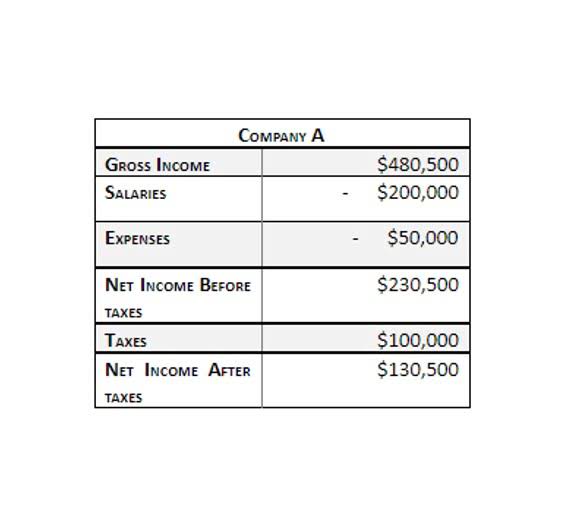
In this case, the retailer may draw on their revolver, tap other debt, or even be forced to liquidate assets. The risk is that when working capital is sufficiently mismanaged, seeking last-minute sources of liquidity may be costly, deleterious to the business, or, in the worst-case scenario, undoable. For example, imagine the appliance retailer ordered too much inventory – its cash will be tied up and unavailable for spending on other things (such as fixed assets and salaries). Moreover, it will need larger warehouses, will have to pay for unnecessary storage, and will have no space to house other inventory. For many firms, the analysis and management of the operating cycle is the key to healthy operations. Conceptually, the operating cycle is the number of days that it takes between when a company initially puts up cash to get (or make) stuff and getting the cash back out after you sell the stuff.
Streamline your inventory management
For example, if a company experiences a positive change, it may have more funds to invest in growth opportunities, repay debt, or distribute to shareholders. Conversely, a negative change may signal that a company struggles to meet its short-term obligations. Software companies generally tend to have a positive change in working capital cash flow because they do not have to maintain an inventory before selling the product. A ratio above 1 indicates good short-term financial health because it means the company has more current assets than current liabilities. Imagine Green Valley Grocers has $500,000 in current assets (cash, inventory, and accounts receivable) and $300,000 in current liabilities (accounts payable and short-term loans).

Current Liabilities
To calculate working capital, subtract a company’s current liabilities from its current assets. Both figures can be found in public companies’ publicly disclosed financial statements, though this information may not be readily available for private companies. A positive calculation shows creditors and investors that the company is able to generate enough from operations to pay for its current obligations with current assets. A large positive measurement could also mean that the business has available capital to expand rapidly without taking on new, additional debt or investors. If your firm experiences a positive change in net working capital, it may have more cash to invest in growth opportunities or repay debt. If it experiences a negative change, on the other hand, it can indicate that your company is struggling to meet its short-term obligations.
- It encompasses current assets such as cash, inventory, and accounts receivable, minus current liabilities like accounts payable and short-term debt.
- It might indicate that the business has too much inventory or isn’t investing excess cash.
- Change in Working capital cash flow means an actual change in value year over year, i.e., the change in current assets minus the change in current liabilities.
- You calculate working capital by subtracting current liabilities from current assets, providing insight into a company’s ability to meet its short-term obligations and fund ongoing operations.
- This situation is often temporary and arises when a business makes significant investments, such as purchasing additional stock, new products, or equipment.
- But it is important to note that those unmet payment obligations must eventually be settled, or else issues could soon emerge.
- If your net working capital one year was $50,000 and the next year it was $75,000, you would have a positive net working capital change of $25,000.
Working Capital Ratio Formula
Current liabilities include accounts payable, short-term debt (and the current portion of long-term debt), dividends payable, current deferred revenue liability, and income tax owed within the next year. Working capital is the difference between a company’s current assets and current liabilities. Working capital is the amount of current assets left over after subtracting current liabilities. A negative amount indicates that a company may face liquidity challenges and may have to incur debt to pay its bills. Working capital is calculated by subtracting current liabilities from current assets. The current ratio, also known as the working capital ratio, provides a quick view of a company’s financial health.
Change in Net Working Capital Calculation Example (NWC)
- We’ll now move on to a modeling exercise, which you can access by filling out the form below.
- Working capital is a core component of effective financial management, which is directly tied to a company’s operational efficiency and long-term viability.
- Much like the working capital ratio, the net working capital formula focuses on current liabilities like trade debts, accounts payable, and vendor notes that must be repaid in the current year.
- While A/R and inventory are frequently considered to be highly liquid assets to creditors, uncollectible A/R will NOT be converted into cash.
- This efficiency helps a business maximize its profitability, as it is well-prepared to handle unexpected expenses or invest in income-generating opportunities without relying heavily on external financing.
- A company with more operating current assets than operating current liabilities is considered to be in a more favorable financial state from a liquidity standpoint, where near-term insolvency is unlikely to occur.
- In our example, if the retailer purchased the inventory on credit with 30-day terms, it had to put up the cash 33 days before it was collected.
It indicates whether the short-term assets increase or decrease gross vs net concerning the short-term liabilities from one year to the next. If the Net Working capital increases, we can conclude that the company’s liquidity is increasing. Some companies have negative working capital, and some have positive, as we have seen in the above two examples of Microsoft and Walmart. Generally, companies like Walmart, which have to maintain a large inventory, have negative working capital. Aside from gauging a company’s liquidity, the NWC metric can also provide insights into the efficiency at which operations are managed, such as ensuring short-term liabilities are kept to a reasonable level.
Credit Policy

Meanwhile, the company experiences rapid growth in production, requiring increased inventory levels and faster payments to suppliers, causing a surge in A/P. In this scenario, the company’s net working capital decreases, signaling potential cash flow constraints and liquidity challenges. Understanding the factors driving changes in working capital is essential for evaluating a company’s financial health and operational efficiency.
- You then take last year’s working capital number and subtract it from this year’s working capital to get change in working capital.
- The amount of working capital needed varies by industry, company size, and risk profile.
- What was once a long-term liability, such as a 10-year loan, becomes a current liability in the ninth year, when the repayment deadline is less than a year away.
- Thus, it’s appropriate to include it in with the other obligations that must be met in the next 12 months.
- A company with positive working capital generally has the potential to invest in growth and expansion.
- This means the company has $70,000 at its disposal in the short term if it needs to raise money for any reason.
- The change in net working capital refers to the difference between the net working capital of a company in two consecutive periods.
Taken together, this process represents the operating cycle (also called the cash conversion cycle). In other words, there are 63 days between when cash was invested in the process and when cash was returned to the company. Therefore, the working capital peg is set based on the implied cash on hand required to run a business post-closing and projected as a percentage of revenue (or the sum of a fixed amount of cash). One nuance to calculating the net working capital (NWC) of a particular company is the minimum cash balance—or required cash—which ties into the working capital peg in the context of mergers and acquisitions (M&A). On the subject of modeling working capital in a financial model, the primary challenge is determining the operating drivers that must be attached to each working capital line item. My Accounting Course is a world-class educational resource developed by experts to simplify accounting, finance, & investment analysis topics, so students and professionals can learn and propel their careers.

How to Find Change in NWC on Cash Flow Statement (CFS)
It is a financial cushion that allows businesses to weather economic downturns, invest in research and development, and seize new opportunities. In essence, it’s like a savings account that businesses can tap into to ensure long-term growth and adaptability in a dynamic market. A high net working capital demonstrates that a company efficiently utilizes its resources. This how to find change in nwc efficiency helps a business maximize its profitability, as it is well-prepared to handle unexpected expenses or invest in income-generating opportunities without relying heavily on external financing. Change in net working capital refers to the differences in the liquidity of the company. As in, it is a measure of if the company will be able to pay off its current liabilities with the assets in hand.
Best Practices Every Cash Manager Should Follow
Below is Exxon Mobil’s (XOM) balance sheet from the company’s annual report for 2022. We can see current assets of $97.6 billion and current liabilities of $69 billion. Current assets are those that can be converted into cash within 12 months, while current liabilities are obligations that must be paid within the same timeframe. For example, consider a manufacturing company facing challenges in collecting receivables from customers, leading to a significant increase in A/R.
